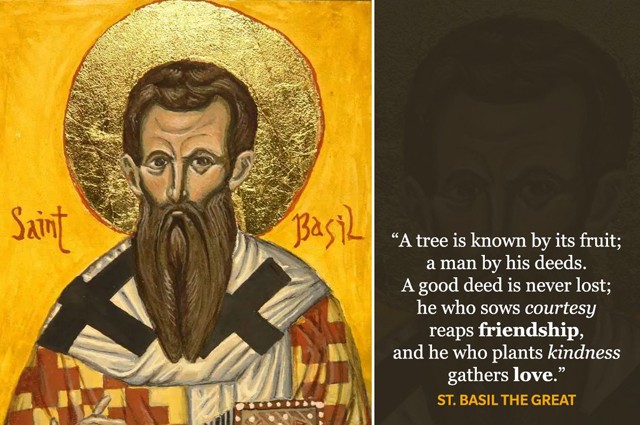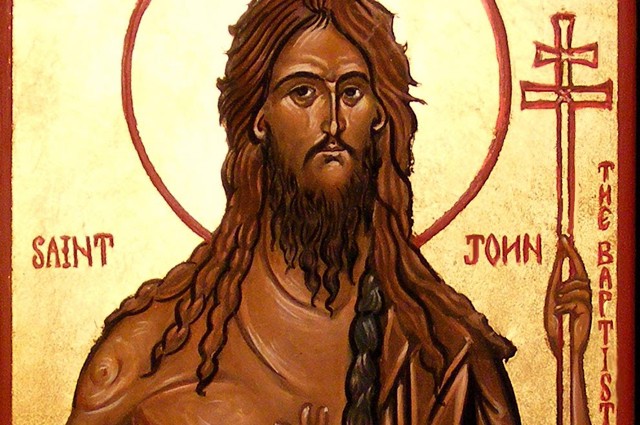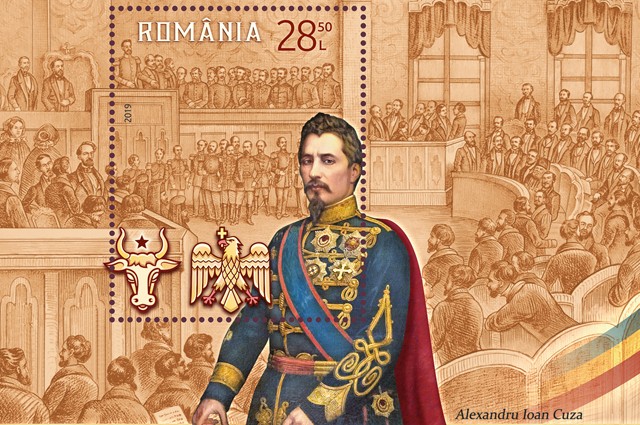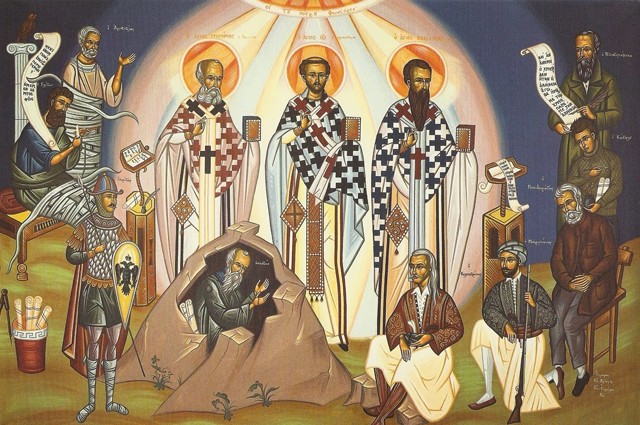The traditions of January in Romania
Postat 04-12-2021
In Romania, the religious life is very important, and the majority of the traditions of each month, are connected in a way or another with the cult of ancestors or with the Christian saints.
St Basil The Great

The first day of the year celebrates the celebration of St. Basil a day with Christian roots, anchored in the great celebration of Christmas, is also called Little Christmas or Brother of Christmas. In popular tradition, Saint Basil appears as one of the saints who have done the greatest wonders, being a guardian of evil spirits.
St. Basil's prayers remove the evil and unclean spirits of men
• On St. Basil's day, it is said that the first guest who comes into your house is good to be a man. How your guest, rich or poor, will be your year. It is good to drink a lot of wine this day, and there is the belief that as long as people drink this day, both blood will have their cheeks during the year.
• The children go with the wishes of St. Basil and wish them the right health and work power. Housekeepers are welcoming and serve them with sweets, fruits, and chops.
• If Saint Basil's night is "smooth and serene," it's a sign that the new year will be a good one.
• Another widespread habit is the attainment of a lamb on St. Basil's day, it brings luck and wealth.
• On the day of St. Basil, the Gypsies are habitually carving with a pork captain, embellished with ribbons and beads, a tradition called "Colindul cu Vasilica". After the caroling, all those who have been caroling gather to a carpet to cook. Then they split up, desecrate the captain and take everyone they put, and make a lunch out of it because the habit is closed for the year.
• It is good to be dressed in beautiful or new clothes on New Year's Day, because now they all come together, and that's how you will go all year long with luck, groan, and joy from the Lord.
St John the Baptist

The Celebration of the Epiphany is the baptism in Jordan's water of the Savior Jesus Christ by Saint John the Baptist
Epiphany is one of the biggest celebrations of the year for the Romans. Usually, during this period it is very cold, hence the phrase "the frost of the Epiphany", which, according to tradition, is a sign of the year.
In the Romanian folk tradition, Epiphany is also called the Jordan Feast. It is a celebration dedicated to the purification of waters and nature.
Traditions of Epiphany:
• On the eve of the Epiphany, the priests go to the homes of the faithful to announce the baptism of the Savior Jesus Christ and to bless the believers' homes by sprinkling the holy water. On the eve there is a day of fasting - those who fast on this day say they are going well all the gold and are lucky.
• According to Orthodox tradition, Christians need to eat boiled wheat and drink red wine, but only after they have held a black post and after the priest sanctified their house. All of this generally has a role to clean and remove the evil.
• On the day of Epiphany, the young people go to the houses of the people and dress the animals for their health and fruit.
• Over the Christian habits of water sanctification have overlapped and many pagan practices, such as smokes of stables and cattle for the eviction of evil spirits of them, the burning of fires on the field or the collins accompanied by all sorts of screams and noises.
• It is believed that if on the morning of Epiphany Epiphany, the trees are loaded with the Prophet, they will have rich fruit.
• Another habit says that women are not allowed to wash their laundry for 8 days in order not to defile the barely sanctified waters.
• If it is cold, prepare an ice cross to mark the place of the job, and at the end, the priest throws a wooden cross into the water. Several men dive into the water to bring it back, and the one who pulls out the cross will have luck all year long.
• If you stop and fall on ice on Epiphany Day, it is sure that you will marry that year.
• Epiphany closes the winter holiday cycle and has, besides the Christian meanings - the moment of the Savior's spiritual birth
• Holy Prophet John the Baptist celebrated on January 7, marks the end of the winter holidays and also those dedicated to the birth of the Savior Jesus Christ. It is also known as "Sant-John" or "Before the Fool," because it announced the coming of the world to Christ.
• It is known from the folk tradition that St. John the Baptist is the protector of the infant, and he protects him from evil, especially, taking care not to die baptized.
• • This day is dedicated to splashing with water or snow to protect against illness in the new year.
• • Some people celebrate St. John's Day for God to guard their homes for wild animals and wild beasts
• Iordaneala
• A custom from the elderly is "Women's Jordan", which is a wife's party.
• • Women gather at a host where they bring food and drink, then spend the morning, saying they are "Jordan".
• Jordan is a habit we meet today, many young people wake up in the morning and go to church to take aghiesm. After the end of the ministry, the young spatter every man who comes out of the church, eating health and happiness. The "Jordanite" people reward the mockers with the money they enjoy on the night of St. John.
• The Ionite
• Another tradition that we meet in Transylvania and Bucovina is the "Ionation of the Ionians".
• • In Bucovina, the gates of all those who have this name are decorated with a fir tree, and they give a party with lautari, and in Transylvania those who wear this name are worn with a great traveler from the village to the evil where they are baptized or purified.
• • The elders say that in the morning of St. John every man must be sprinkled with aggression, in order to be free of diseases throughout the year.
• • According to popular tradition, St. John is baptized with frost, that is, he softens the cold and begins to make himself warmer.
The Union of Romanian Principalities

Every year on January 24th, we are proud to remember the great act of the Union of Romanian Principalities, which laid the foundations of the modern Roman state.
• • The union of the Romanian Country with Moldova, made on January 24, 1859, represents the political act underlying modern Romania and the formation of the Romanian nation. Historical circumstances did not allow the simultaneous unification of the three Roman countries: Moldova, Transylvania, Wallachia. The Romanian national state gradually formed, starting with the Union of 1859 and ending in 1918, when the struggle for the national liberation of the Romanian people would be crowned with victory.
The Union of the Romanian Principalities
• • Wallachia and Moldavia at that time were two different countries, united on January 24, 1859, under the joint leadership of Alexandru Ioan Cuza.
• • On January 5, 1859, the Elective Assembly in Iasi elected Alexandru Ioan Cuza as the ruler of Moldavia. Since the first day in Bucharest, over 30,000 people mobilized by the young unionists gathered in front of the buildings where the Elective Assembly took place.
• • On the morning of January 24, at 11:00, Vasile Boerescu asked for a secret meeting where he said "To unite on the principle of union is to unite upon the person who represents this principle. This person is Alexandru Ioan Cuza, Mr. We will unite on this name and the posterity will bless us, the country will stretch our hands and our consciousness will be reconciled to us ... a holy desire. "
• Alexandru Ioan Cuza was elected President of the Romanian Lands on this day, and the deputies had to vote unanimously in fulfilling the will of the people.
• • The election of the same prince in both Principalities was a significant victory for the Romanian people in their struggle for the formation of a unitary national state.
• • This morning, flowers and crowns go to the ruler's statue followed by various cultural manifestations in honor of Alexandru Ioan Cuza.
Tradition of Lifting to the Beam
Lifting to the Beam ( Datul la Grindă) is a tradition that keeps dating from the Geto-Dacians and celebrates the first day of the year, January 1 for children up to three years of age. This ritual was initially committed by the priest, but the number of children was great, it was allowed that this ritual be done by the baby's midwife, nose or even father.
• • Tradition says that the child is given the beam to rise, grow tall and beautiful, and after modern interpretations, aspire to great things.
• At the door, the child rises three times from the floor to the beam and says, "Be down, baby up to big and beautiful."
• During the beating, the child must have a bobbin in which three basil and money are placed. At the threshold of the door are sunflower seeds, wheat, and corn seeds together with an iron bar. It is said that iron has the role of strengthening and protecting the bad child and the seeds to be fertile.
• On this occasion, the whole family gathers around the table, they make gifts and celebrate the beams of the little one.
The Holy Three Hierarchs

Every year, on January 30th, the faithful celebrate the day of the three saints, Vasile the Great, Gregory the Theologian, and John Chrysostom known as The Holy Three Hierarchs. All three were considered Christians, they contributed essentially to Christian theology and were appointed as the protector of theological education.
The joint celebration of the three was decided at the end of the 11th century, because the believers wondered who, among the three, was bigger. But we must know that each is celebrated and separated.
Traditions:
• The elders say that it is good to have a candle on this day. It is said that you will have a whole life, full of light. There is also a „coliva” ( that must be taken into the church and established, then divided into the poor people. Orthodox Christians consider coliva to be the symbol of death and resurrection, according to the words of the Gospel: „Verily, verily, I say unto you, Except a grain of wheat fall into the ground and die, it abideth alone: but if it dies, it bringeth forth much fruit.” (John 12:24)
Wheat which is planted in the earth and rises in new life is symbolic of those beloveds departed who have died in the hope of resurrection, in accordance with the words of Saint Paul: „So also is the resurrection of the dead. It is sown in corruption, it is raised in incorruption. It is sown in dishonor, it is raised in glory. It is sown in weakness, it is raised in power. It is sown a natural body, it is raised a spiritual body....(1 Corinthians 15:42–44)”
This symbolism has its highest expression in the Saints, whose blessed state in heaven has been manifested to the world. For this reason, koliva is blessed not only at memorials for the departed but also in commemoration of saints.
Other traditions are:
• About the work of the field and about the weather it is said that on this day the gray under the snow grew, the one who remained untouched by the autumn.
• Also on this day the weather changes. If the stresses flow, the spring is cold; if it is cold, the summer is warm.
• The popular tradition says about who will work this day that he will go wrong "in the house".
• Young girls are praying to have a happy marriage and are also feasting to commemorate the dead of the faithful families
